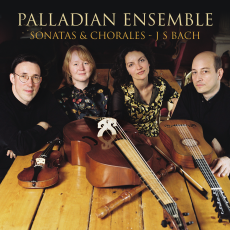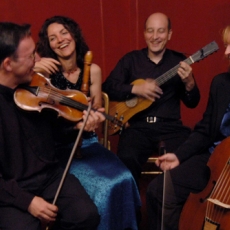Bach - The Palladian Ensemble - MusicWeb-International.com
This disc focuses on the trio sonata in Bach's oeuvre. Only one piece is performed in its presently known form, the Sonata for violin and basso continuo. One may ask why this piece is included. In the booklet William Yeoman writes that "its texture is quite clearly that of a trio sonata". So most of the pieces on this disc are arrangements of some sort. As Bach himself quite often reworked his compositions there is no objection against making and performing such arrangements. What is decisive is whether the result is convincing and whether the arrangement does justice to the character of the original.
The basic idea behind the form of the trio sonata is the collaboration and competition of two equal upper voices over a basso continuo. In his book Versuch einer Anweisung die Flûte traversiere zu spielen Johann Joachim Quantz writes that in a trio "one scarcely can guess which of the two voices is the first". Here the balance between the two upper voices is a recurrent problem. The disc starts with a trio sonata which was originally written for two flutes. Here the recorder is no match for the violin, in particular in its lower range. In the two other trio sonatas the balance is better, mainly because of the higher tessitura of the part which the recorder has to play. These works were written for the organ and intended as study material for Bach's eldest son Wilhelm Friedemann. But as it seems they are partly reworkings of older material for melody instruments there is nothing against going into the opposite direction. In general they work rather well, although I would have preferred another instrument instead of the recorder. One has to consider that Bach in his chamber music - at least what is left of it - never wrote anything for the recorder.
The performance of the chorale arrangements isn't always satisfying either. Some involve reworkings of existing material, for example from his cantatas. And again, going in the opposite direction could be interesting. Some of Bach's organ works have the texture of a trio, as titles such as "trio super" would seem to indicate. The difference between the organ and this ensemble is that on the organ one can choose the stops in such a way that all parts are clearly audible. In 'Wachet auf, ruft uns die Stimme' the chorale melody is played on the recorder, and this results in too much of the detail being subsumed into Bach's polyphonic web. Where a treble recorder is used, as in 'Allein Gott in der Höh sei Ehr' this produces much better results.
On the whole the playing of the Palladian Ensemble is accetpable, although I find the lack of a keyboard instrument in the basso continuo regrettable. The combination of viola da gamba and archlute is insufficient to drive the upper voices on. Sometimes the tempo is sketchy. The middle movement from the Trio Sonata No. 4 is too slow: played like an adagio rather than an andante. The performance of the vivace from the Sonata BWV 1021 is pretty tame. Another point which struck me is that the violin fails to sound as brilliant as it could be; probably a matter of recording technique.
To sum up: the concept of this disc is quite interesting, but its realisation is less than ideal and it does not always do justice to the character of Bach's compositions.

